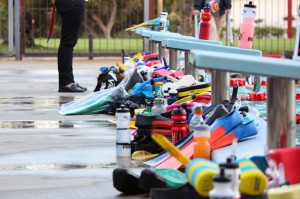United States Masters Swimming (USMS) got started in May of 1970. Read more HERE on the history of USMS. I started my masters swimming career in the mid 80's and started coaching in 1991. Over the past 35 years I have been fortunate to have some great mentors and have learned many things from the athletes I coach. Writing a good workout takes a bit of planning by the coach and combined with managing the lane flow leads to a great workout for the swimmers. Here are some thoughts I have on doing just that.
- How to write the workout
- Identify the goal of session
- Free - Sprint, Mid, Distance, Tri/Open water
- Stroke/IM
- Technique
- Combo
- Repeat distances 25’s, 50’s, etc...
- Aerobic, Anaerobic, both
- What the pool dictates
- Warm up
- With a 60 minute session, I give them 10 minutes of easy swim, kick, drill on their own. Masters bodies have many different warm up needs. Some swim, some talk on the deck but whatever works for them in those 10 minutes. Speed days I like to give them 15 minutes of general warm up. Some dryland exercises are also good prior to getting into the pool.
- Transition set
- Can really be anything that helps them transition the heart rate up and a technique focus component as well.
- Main set 1 or 2
- Depending on the workout goals 1 or 2 main sets is more than enough
- Cool down
- I always encourage it but generally leave that to the individual
- Identify the goal of session
- How to explain
- Written
- White board - Write legible, write BIG, Use black or blue pen that shows up best for those aging eyes
- Printed for each lane - Print a copy of the workout that each lane can have. Helps for those that can not see the white board and those that process by reading what they are doing
- Pre workout email
- Find what works best and it might be a combination of all
- Verbal
- Group - Talking to the whole group at the beginning of practice to go over goals for the day. Need a big voice for this!
- Individual lane - Giving each lane their instructions. Usually intervals to swim on, number or reps and lane order suggestions. Make sure FOB knows what to do. More on this later.
- Individual - Individual instruction, short cues to help swimmers with technique or questions about the set.
- Visual Demonstration
- Swimmer - Often very helpful for experienced swimmers in the workout to demonstrate technique or a specific drill.
- Video - Having swimmers see the correct way to do something is very helpful. Also, having them see themselves swim so they can make the needed adjustments.
- Written
- How to execute
- Lane Dynamics
- Set the lane up for success… managing the flow. This is one of the things IMO that separates good coaches from great coaches. A great coach will monitor this and make micro adjustments to swimmers, rest intervals and set objectives to fine tune the session. I sometimes like to describe lane positions much like riding a bus: Front Of the Bus (FOB), Middle Of the Bus (MOB), Back Of the Bus (BOB).
- Front Of the Bus (FOB) - This is your lane leader and critical for the lane functioning and flowing well. Must be reasonably good with the clock, pacing and counting laps. When giving instructions to the lane/group, make sure FOB is onboard. If FOB is not good then MOB and BOB have the potential to go astray and lane chaos quite possible. One thing that helps the whole lane is a set of 25’s or 50’s where everyone in the lane gets to be a FOB, MOB and BOB. This helps the swimmers appreciate all the work a FOB must do to keep the lane flowing and also gives confidence to the MOB and BOB that if put into a FOB position, they can lead the lane with confidence.
- Middle Of the Bus (MOB) - The majority of the lane falls here with order TBD based on type of set and who is wearing what. Often swimmers that could lead but would rather follow due to pacing or clock skills. Lots of the MOB and BOB also like to draft as that is easier 2-4 seconds per 100. Along those lines the MOB can really have some speed variances if you combine the draft + using gear; it is not uncommon for swimmers to have 7-10 second per 100 differences in sustainable speed.
- Back Of the Bus (BOB) - Usually the slowest swimmer in the lane, does not want to be in anybody’s way, has no desire to lead, just wants to follow/draft. Having an off day but wants to be a part of the lane. BOB shares many of the characteristics of MOB but generally just a slower pace that can still function in the lane. Depending on pool dynamics, BOB could be asked to move down a lane and lead if the current lane has too many bodies. Same goes for a FOB that could be moved up a lane and be a BOB or MOB
- What are you wearing?
- Paddles, Fins, Snorkel, Buoy - Can change flow of lane and swimmer speed 7-10 seconds per 100 and interval capacity 5-10 seconds per 100. As noted above this has big impacts in the MOB.
- Lane Dynamics
There are endless combinations of swimming sets to create workouts. Combining that with good lane management will help give the swimmers you coach the best possible experience.
Have fun with it all, Coach Eric


0 Comments